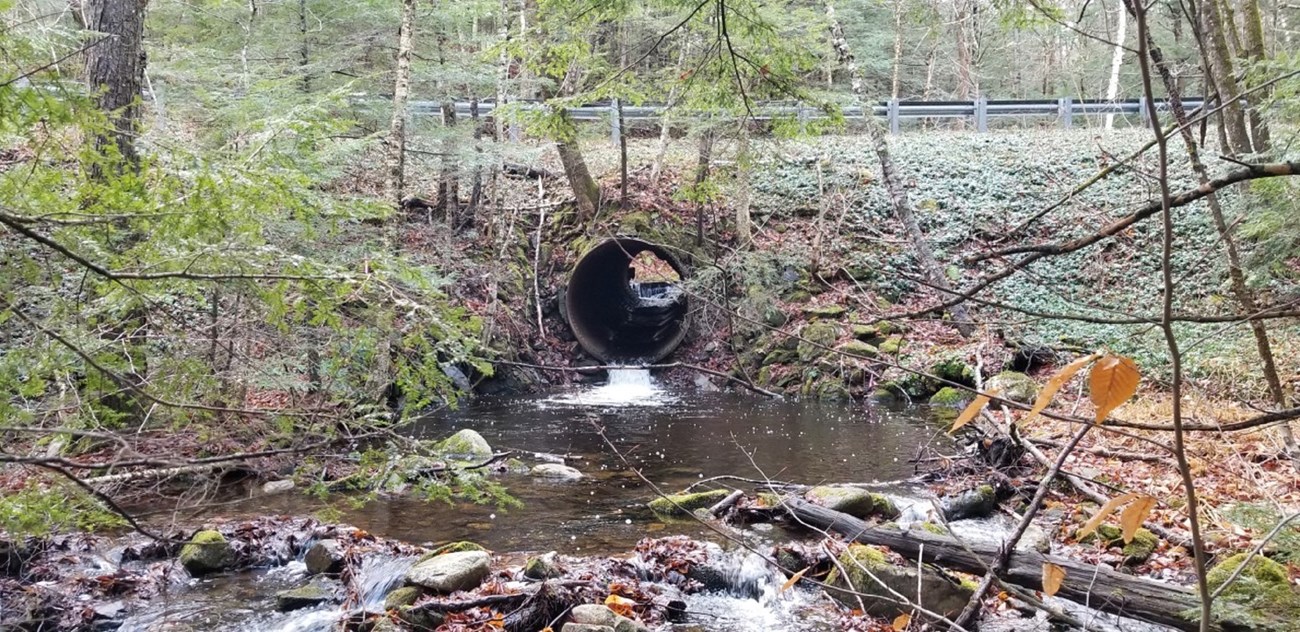Last updated: November 24, 2020
Article
Partner Spotlight | Tackling Culvert Problems in the Westfield Watershed
by Cassidy Quistorff, NPS Communications Fellow
Culverts and small bridges that make up our transportation network are often an unnoticed threat to rivers. Much like the aquatic barriers created by dams, roads that fail to allow rivers and streams to flow naturally disrupt aquatic ecosystems. Poorly designed road-stream crossings fragment habitats causing wildlife to risk becoming roadkill and disconnecting fish from more suitable habitats upstream of the road. Failing and undersized culverts and bridges disrupt the flow of ecosystem services and jeopardize transportation infrastructure by clogging with debris and eroding the stream channel and banks. Today, watershed groups are helping municipalities prioritize the replacement of culverts to better serve their rivers. For the Commonwealth of Massachusetts, replacing these culverts to the MA Stream Crossing Standards is a high priority for both transportation resilience and ecosystem health.
The Wild and Scenic Westfield River Advisory Committee has made improving road-stream crossings a priority. Their efforts began several years ago when the Committee was able to engage interns from the local university to undertake assessments of the road-stream crossings in the watershed. The collected data was used to prioritize the crossing presenting the worst barriers to connectivity . This ranking was further refined to identify structurally compromised culverts likely to need replacing in the near term.

The next step was to engage the Wild & Scenic towns to identify how the Committee could help the towns and the river address the prioritized culverts. The next step taken was to work with three communities with culverts at the top of the list. The Committee took on the task of managing and funding the initial assessment and concept design work for five culverts and assisting the towns with a grant application to fund the next steps. The Committee served as the project manager taking the burden off the small towns to manage the work. Bundling five separate culverts into one contract also produced a cost savings . All three towns, Becket, Cummington and Windsor Massachuestts , submitted grants to further the culvert replacement to MA Division of Ecological Restoration's Culvert Replacement Municipal Assistance Program.
In 2019, the Town of Windsor, Massachusetts received a large grant to replace problem culverts on Westfield’s East Branch. With funding through a stream community grants program, they were able to bring in professionals which provided an initial culvert project design. This provided a bases for a larger grant application to the Massachusetts Department of Ecological Restoration (MDER).
Jim Caffrey, the Town of Windsor representative for the Westfield Wild and Scenic River Committee, provided technical assistance for the culvert survey. A major gain of properly sized culverts is stream continuity for fisheries and wildlife; Jim sees other exciting benefits, too. “Maybe even a bigger selling point would be storm resilience… getting worse pop-up storms that nobody can predict, and they’ve been overwhelming the smaller culverts.” Storm resiliency is a major consideration when factoring in culvert design. According to the MDER, there are over 20,000 undersized culverts within the Commonwealth. This issue will only continue to have detrimental effects as stronger storms become more common as a result of a changing climate.
After receiving the MDER grant, the Town of Windsor, the MA Department of Public Works, and the Westfield Wild and Scenic River committee are partnering on this project to replace culverts in the Westfield watershed. They are set to be in place next year. Jim explained his excitement at the prospect of this successful partnership, “It’s great to be in Windsor and see this happening... [I’m] hoping to point to these successes and say it wasn’t that painful [laughs] – it was a good process!”
The Westfield Wild and Scenic River offers many exciting examples of what being a Partnership Wild and Scenic River can achieve. For Jim, he wouldn’t have it any other way. “I like doing it this way; it’s grassroots; it’s what you make of it.”
